Ah…the Kansas prairie. A land of wide-open spaces that evokes images of cattle drives, farmers on tractors, wheat fields, and the world-renowned Dorothy and Toto. This isn’t the type of place I would have thought to look for an example of designer Dick Newick’s Tremolino, a fast and futuristic-looking trimaran. Yet, on a quiet reservoir known as Cheney Lake just south of Wichita, BLUE MOON quietly awaits—poised for speed. Who’d ’a’ thunk it?
The Wichita area is a hotbed for aerospace technology. That may explain the high-tech-looking trimarans and catamarans that abound on Cheney Lake. Now we know how rocket scientists have their fun. It took BLUE MOON’s builder and owner, Lew Enns, and his good friend, Tom Welk (neither of whom is a rocket scientist), several years of part-time work to complete her. Their hard work paid off, though; she’s head-and-shoulders above the rest on Cheney Lake.
Please don’t send letters. This truly is a handmade wooden boat. While she may look like something out of science fiction, there’s much less new technology at work here than one might guess. In fact, its core technology has been around for millennia.
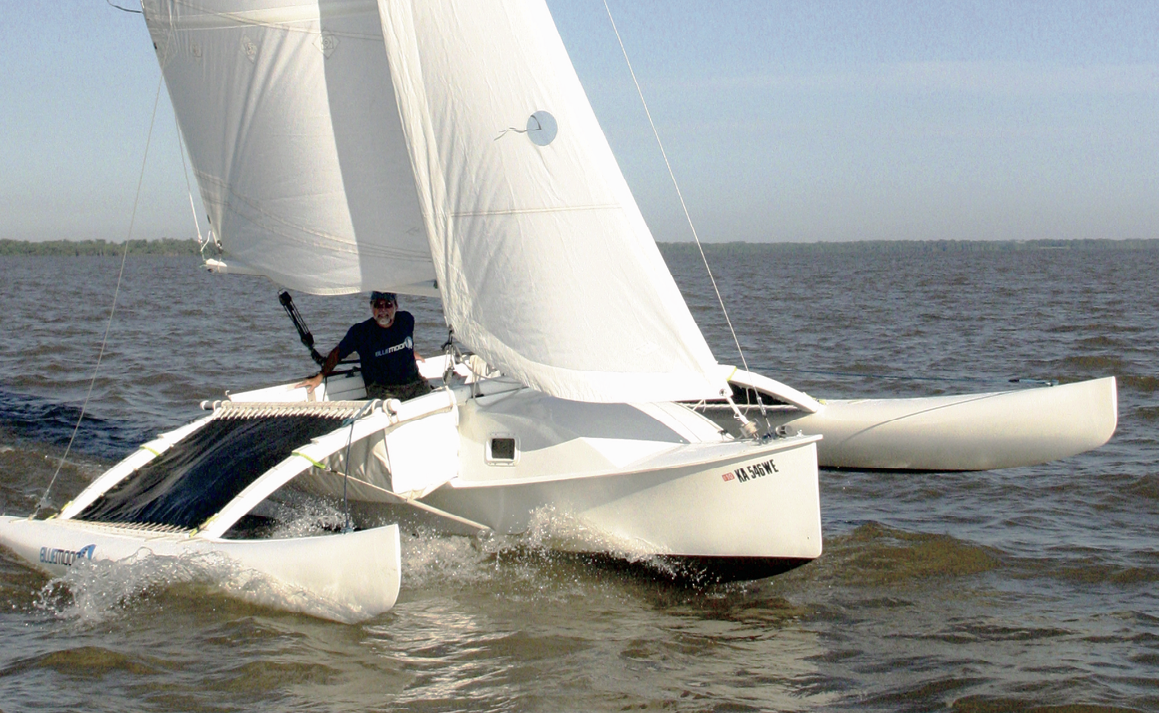 Photo by Tom Welk
Photo by Tom WelkThe Dick Newick–designed Tremolino blends ancient technologies with high-tech design and construction methods. The strip-built trimaran gives even the less-experienced builder a chance to own this fast and fun-to-sail craft.
Dick Newick says, “ Thousands of years ago when early Europeans had trouble crossing small bodies of water, the people of Southeast Asia developed craft with more than one hull which they used to explore and settle the widely separated islands of the Pacific. If they had ever been motivated to leave this paradise for a cold climate, they might have astonished the natives of Europe long before Magellan ‘discovered’ the Pacific and their light multihulls that easily sailed three times as fast as his heavy vessels. The rest of us are slowly relearning what those ‘ignorant savages’ knew a long time ago. CHEERS! to those salty seamen.”
First-time trimaran builders Lew Enns and Tom Welk, while perhaps not as salty as our Southeast Asian predecessors, have done an outstanding job in constructing BLUE MOON. Lew studied other designers’ trimarans before settling on Newick’s Tremolino, but most of them used parts from beach catamarans, giving them a patched-together, discordant look to his eye. Tremolino is a unified original. Lew says, “I really like the looks of Newick designs. They seem like works of art.” Another important consideration for Lew and Tom was determining where the boat could be built. They wanted a design that could fit inside a 24′-long, two-car garage. The 23′ 6″ Tremolino “just fit” when set at a diagonal.
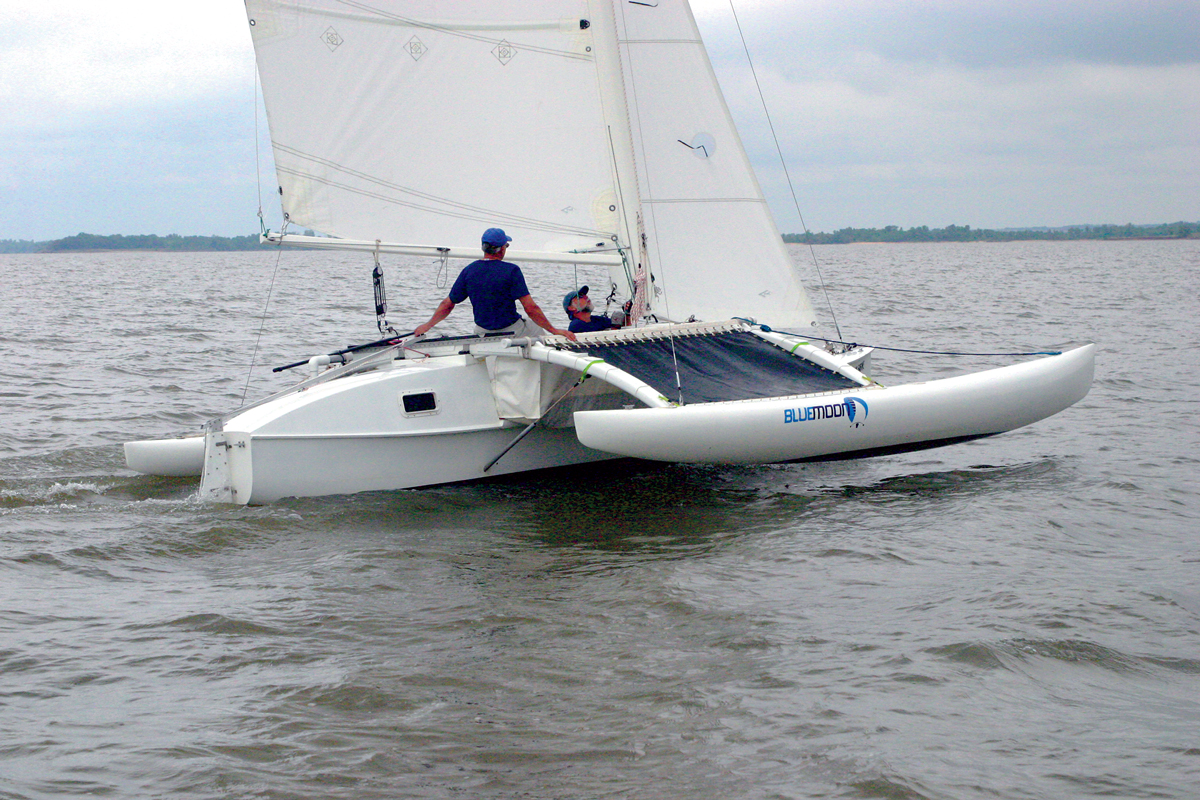 Photo by Karen Wales
Photo by Karen WalesBuilding BLUE MOON was a community effort. Tom Welk (left) joined family members and others to help owner Lew Enns (right) with construction. Lew’s son, Greg, designed a logo for added panache.
Lew and Tom ripped out miles of 3⁄ 8″ 3⁄ 4″ Western red-cedar strips in preparation for building the hulls. The stock was only 8′ or 10′ long, so they scarfed the pieces to get the necessary length prior to ripping. During the earliest stage of BLUE MOON’s construction, a new home was being built near Lew’s place, and the owner graciously saved the offcuts and scraps for his neighbors’ use. Lew and Tom recycled these materials, turning throwaways into their strongback, some of the molds, cross supports for the hulls, and a variety of jigs.
The Tremolino is a trimaran with a large, main hull, called a vaka, bounded by two smaller hulls known as amas. The cross beams that connect the three members are known as akas. Since the amas are the smallest hulls, and since they were to be built in halves on female molds (which can produce an outer hull that is truer and easier to fair), they seemed less daunting to Lew and Tom. So that’s where the builders began.
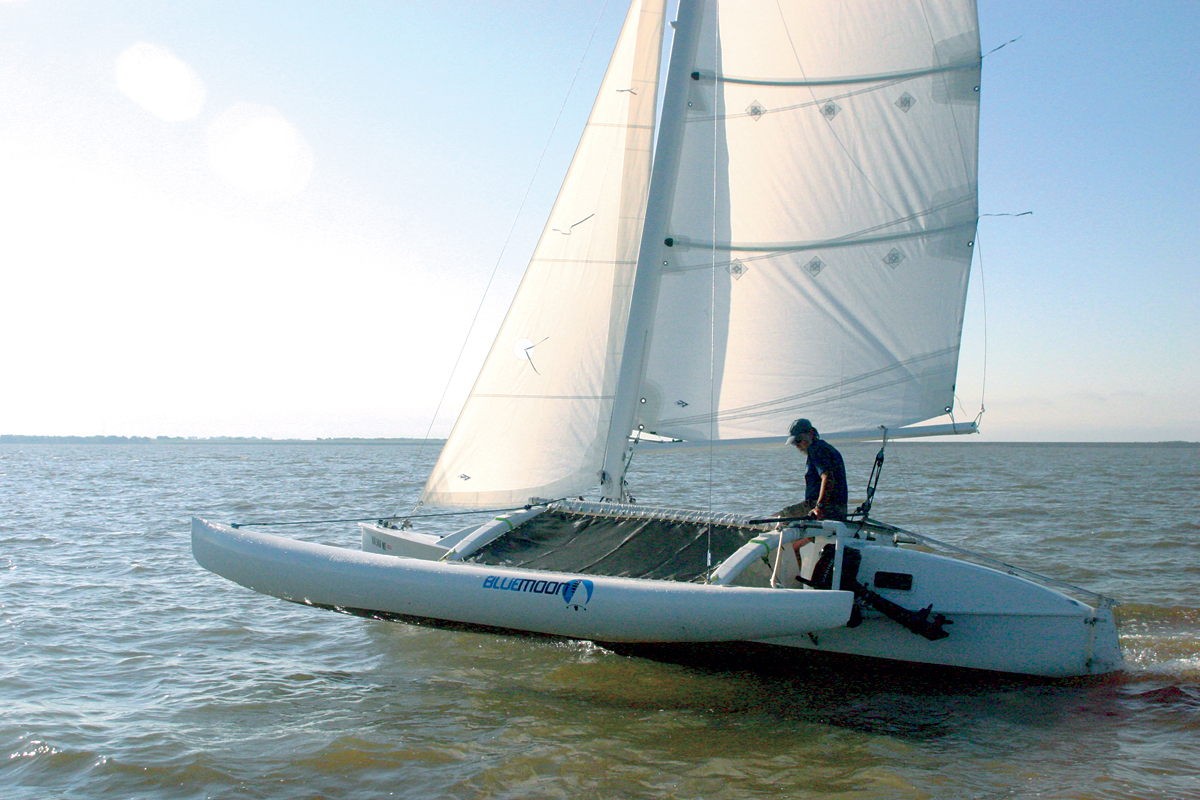 Photo by Tom Welk
Photo by Tom WelkTwo outer hulls, called amas, give balance to the central hull, known as the vaka. Fore-and-aft crossbeams (akas) tie the boat together. Unlike a monohull, the vaka is not designed to be stable without the support of the amas.
No lofting is required to take the Tremolino plans to full scale; molds need only be traced and cut from the full-sized patterns. Lew and Tom were faithful to Newick’s plans, which specify stations spaced 12″ apart. After sheathing the molds with waxed paper, Lew and Tom laid in epoxied strips and temporarily fastened them with 1⁄4″ staples (with waxed ends) that could be set about 1⁄8″ proud for easy removal. The builders averaged six to ten strips per evening. After building the first set of ama halves, they reversed the molds to build the opposing, complementary ones.
In contrast to the amas, the vaca was built on a male mold setup. While the strips went on more easily than they did on the female molds of the amas, fairing was much harder. Tom passed this friendship test with flying colors, working many evenings alongside Lew. There were more tests to come, especially when lining up holes in ama halves to ensure a perfect fit in final assembly. Here, Lew deemed Tom a saint, as his stalwart friend endured hours of the measuring, fitting, and cussing that went into this critical step.
The akas were laid out on a strongback, which established bends in each one according to dimensions shown on the plans. This bending took the Douglas-fir almost to the breaking point—but designer Newick’s procedure worked well, and the completed akas came out fine. The cabin sides, foredeck, cockpit floor, and bulkheads are of okoume plywood. BLUE MOON’s cabintops are strip- built, and all three hulls are sheathed in 10-oz ’glass and epoxy.
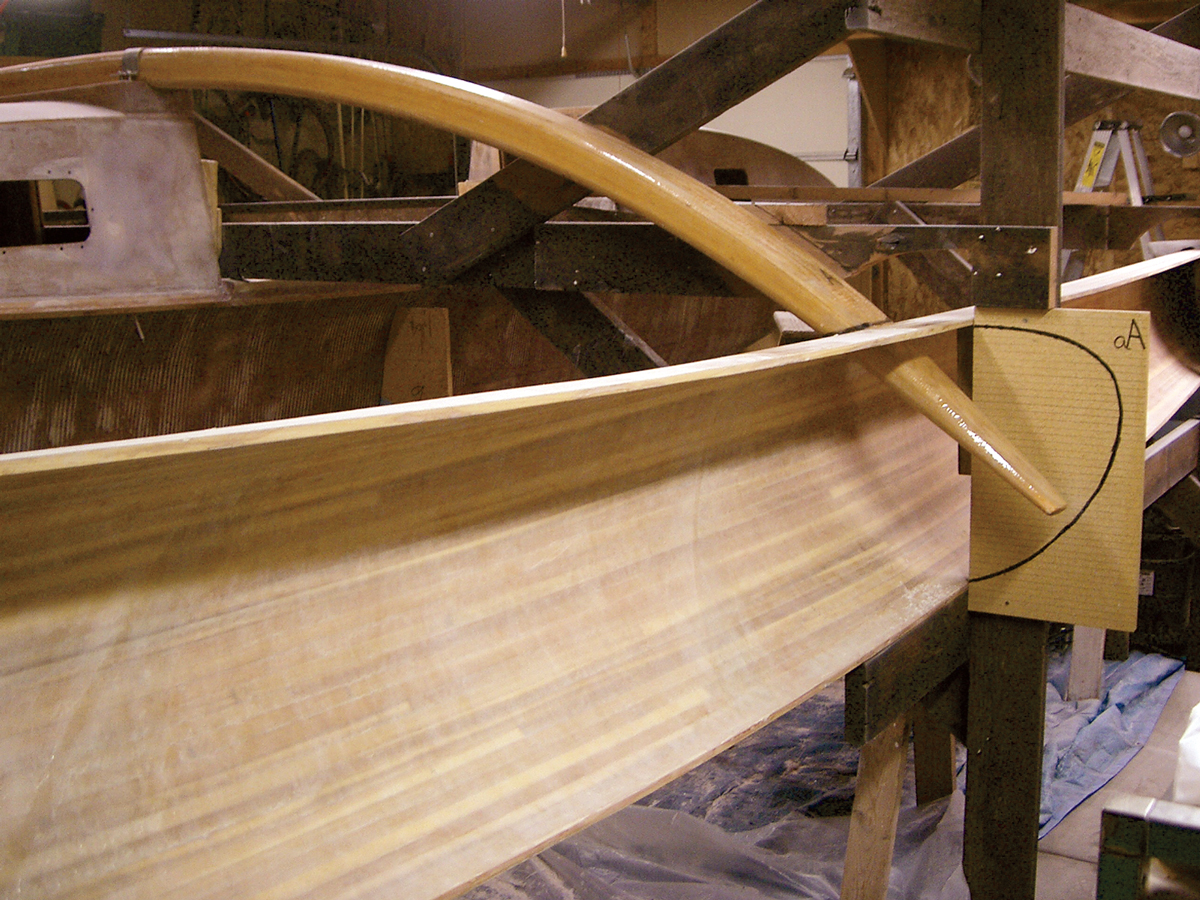 Photo by Lew Enns
Photo by Lew EnnsPlacing the akas at the correct attitude through the inboard ama halves was one of the most critical opera- tions of BLUE MOON’s construction. Lew and Tom used a profile of each outboard ama half to ensure that both the angle and the depth of the akas were dead-on.
Dick Newick is one of the true pioneers of trimaran design in the western world (see WB No. 202, “Multihull Pioneers”). His designs take to the water like a feather drifting on a summer breeze. They look like they are moving fast even when moored. Years ago, when I was a design student at The Landing School in southern Maine, Dick Newick came to introduce us to the basics of trimaran design. His philosophy of simplicity and lightness, lightness, lightness impressed me greatly then, as it still does. His designs are not only fast (winning ocean races far and wide), but all of them are extraordinarily beautiful. In a way, BLUE MOON is high-functioning sculpture. If you are lucky enough to build a Tremolino, I hope you will follow Lew and Tom’s good example in adhering closely to Newick’s design.
If, like me, you are accustomed to sailing a monohull, this boat’s speed will knock your socks off. Kept light, she will attain velocities that one can only dream about with an average 24′ daysailer, and she will do it with just a few degrees of heel. Attaining these speeds with a monohull would require a perfect close reach heeled down on her ear. For me, less heeling means expending less energy. For some, it may also mean fewer bouts with seasickness.
The amas, though usually waterborne, provide the vaca with superb balance and agility, like a figure skater with arms in graceful extension. Because she’s a trimaran, BLUE MOON doesn’t turn on a dime, but she tacks without the awkward bumpiness associated with a catamaran.
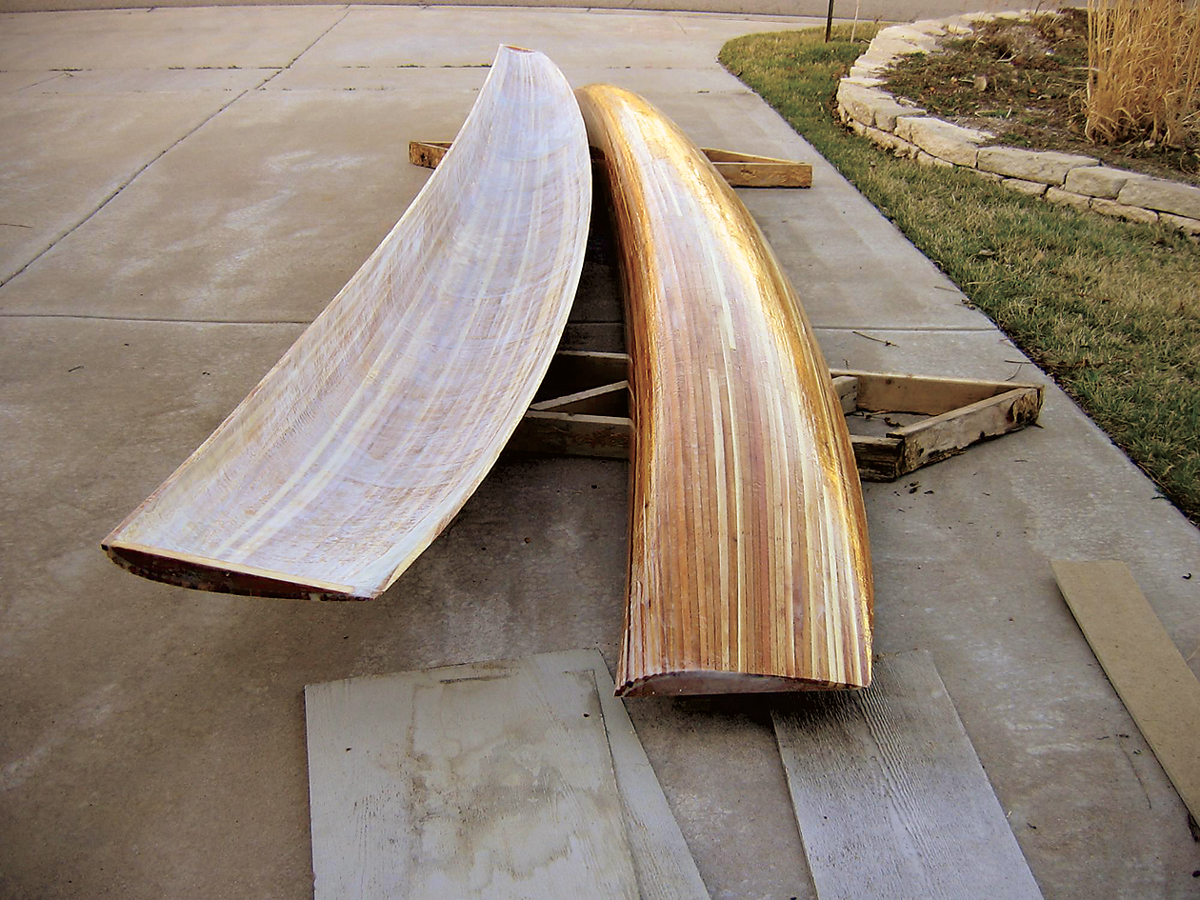 Lew Enns
Lew EnnsThe amas were constructed in halves in a female mold. After gluing up strips for both parts of one ama, molds were reversed on the strongback to build a complementary pair.
Most owners understand that every boat is a collection of strengths and compromises. Boats that are easy and fun to use are seldom as easy to build. BLUE MOON fits that description. Another downside is that the Tremolino is not easily trailerable, although Lew and Tom are working on a customized trailer to make transport a bit easier. For now, though, she clips across Cheney Lake at a full run, or basks in her shady slip. She’s the queen of the Kansas prairie and an icon of the Newick fleet.
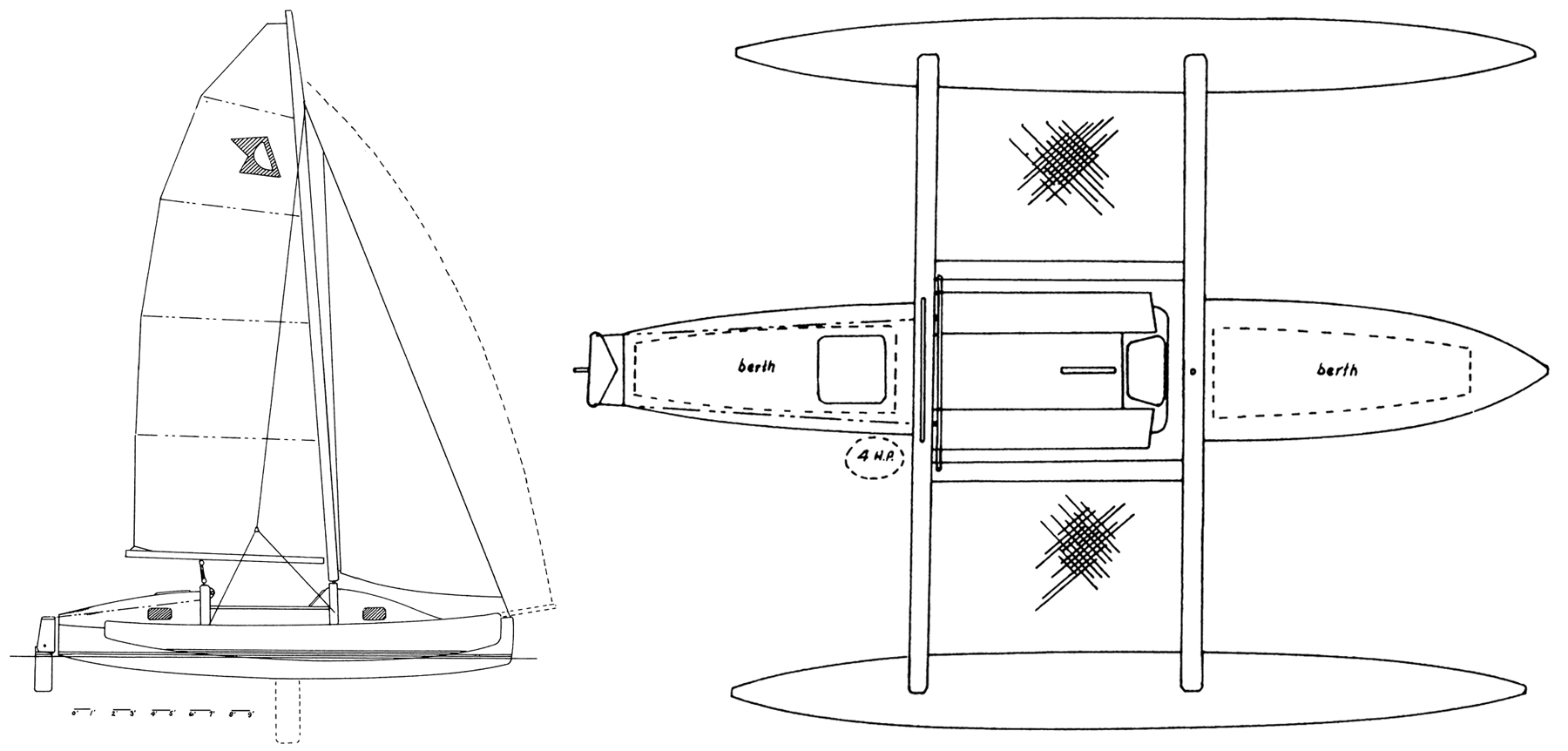
Tremolino is a sophisticated modern sailing machine whose construction is within reach of the dedicated amateur. The plans include full-sized patterns, so no lofting is necessary.
This Boat Profile was published in Small Boats 2009 and appears here as archival material. If you have more information about this boat, plan or design – please let us know in the comment section.
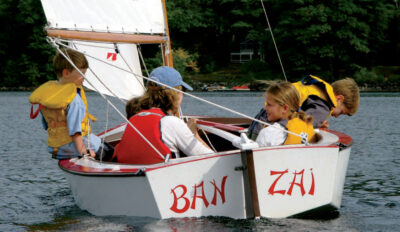
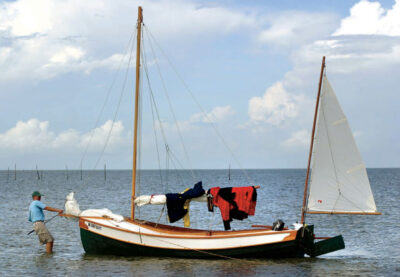
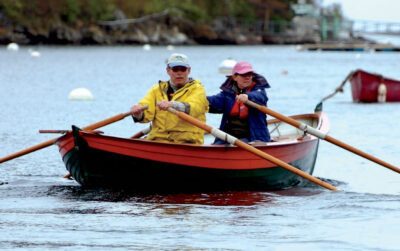
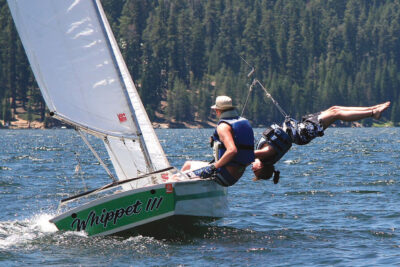
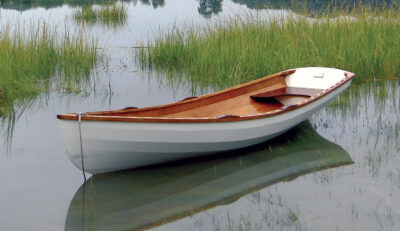
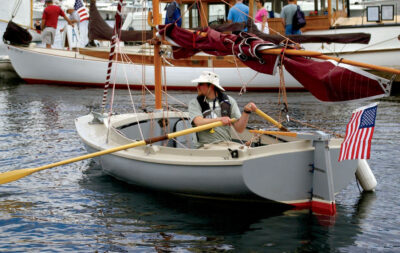
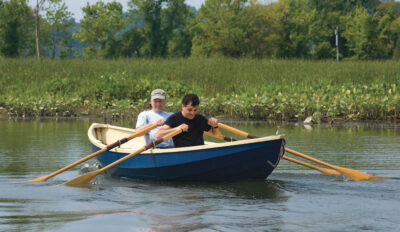
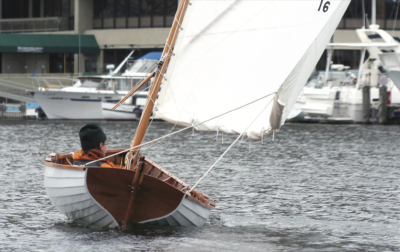
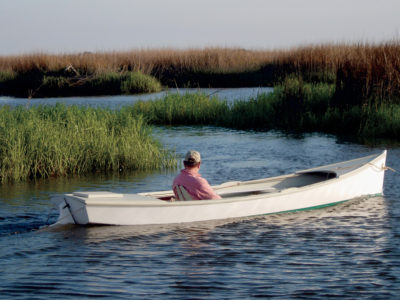
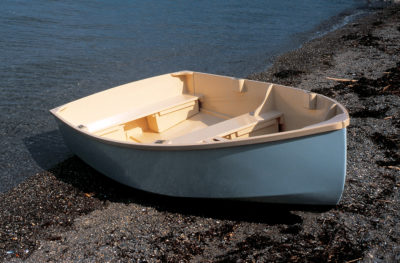


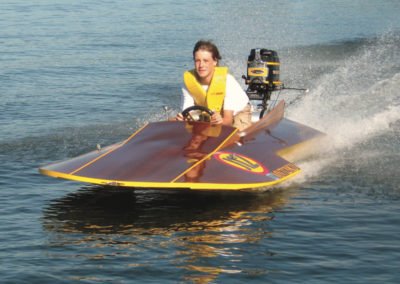
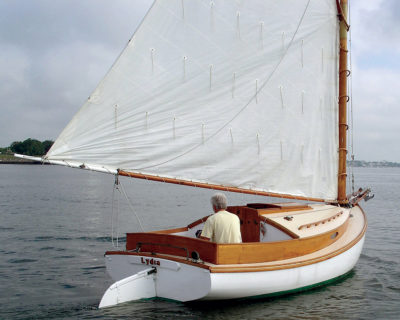
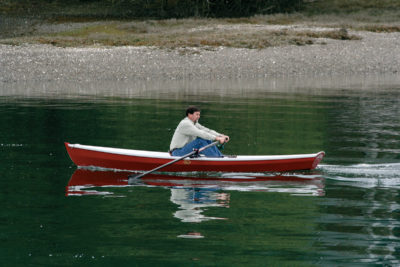
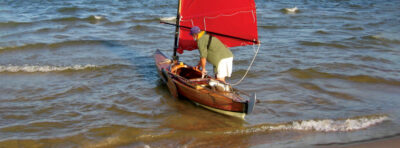
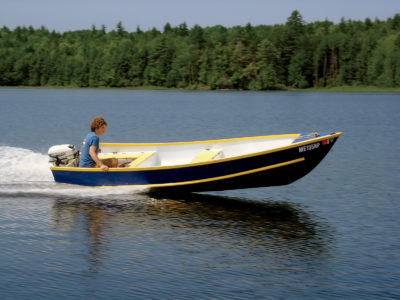
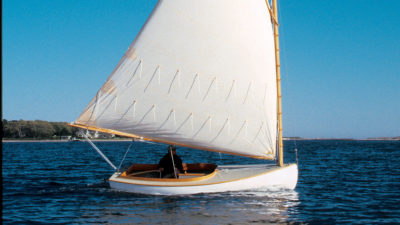
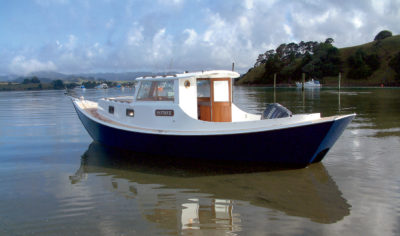

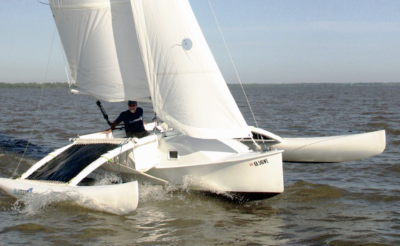
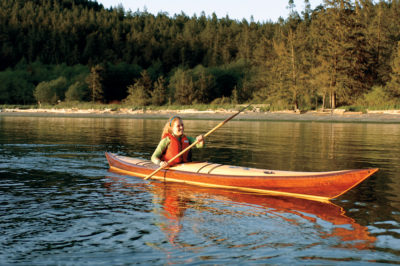
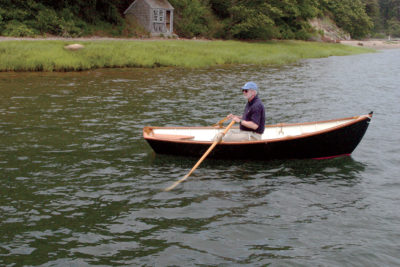
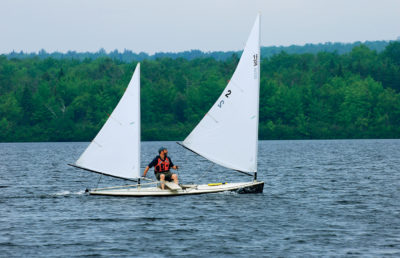
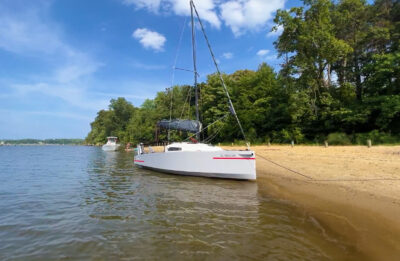
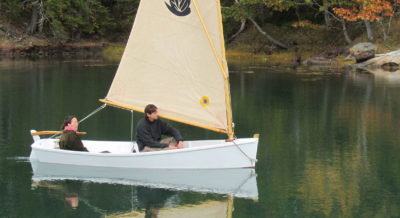
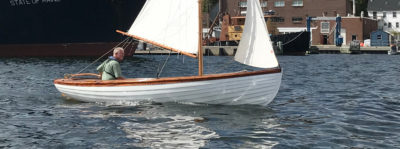
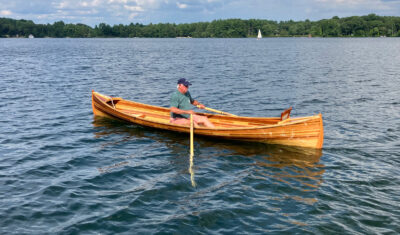
I have two of these fantastic boats and both are for sale.
I was looking for one of these. Are yours for sale?
I always wanted a Newick Trimaran and corresponded with Newick several times. I was at the Gougeon Brothers shop several times while they were building Rogue Wave and saw her, finished, sitting quietly on the banks of the Saginaw River awaiting delivery. I have a copy of Nautical Quarterly 2 which has a long feature article on Newick and his career and later a long section on Rogue Wave. God knows what it would cost to get one today.
I also own Nautical Quarterly No.21 with a feature article on Phil Bolger and his boats, several letters with Bolger and Harold Payson, and several Bolger books. There are no Newick books, alas. I built two Bolger boats, a Teal and a June Bug. The June Bug building involved a tech at the Gougeon Brothers and humorous exchange. The short version is it wound up being built of 1/4 inch luan and has no fasteners left in the hull. Two Bolgers and no Newicks is an indication of my construction prowess.
The only thing about this boat that bothers me is the lack of usable space; the akas are at such a steep angle, the trampolines are almost useless, and the front/rear cabins cannot be used either (unless you want to slide off into the ocean). I would feel claustrophobic (trapped?) in this boat.